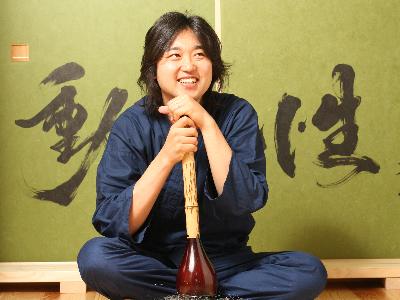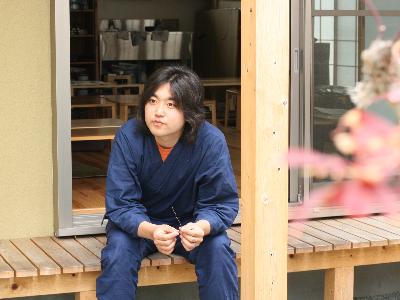|
Souun Takeda, a calligrapher, was born in 1975 in Kumamoto. He started calligraphy when he was three years old, studying with his mother, Souyou Takeda, also a calligrapher.
After graduating from Tokyo University of Science majoring in Science and Technology, he worked at NTT for three years before he became a calligrapher. Since then, he has established himself through a series of unique and original pieces, often collaborating with other artists in various fields including Noh and Kyougen actors, sculptors and musicians, and unconventional one-man exhibitions. He also runs a calligraphy school where many of his students study. “Calligraphy is the same as a conversation. I just use calligraphy to communicate with people”, says the gentle but passionate Mr. Takeda, who is hailed as the new generation of calligraphy.
In 2003, Mr. Takeda received the Longhuacui Art Award from Shanghai Art Museum in China and the Constanza de Medici Award in Firenze, Italy. His work includes title letterings for many movies such as Spring Snow and Year One in the North. He also published three books; Tanoshika, Shoyudou and Sho o kaku tanoshimi.
After graduating from Tokyo University of Science majoring in Science and Technology, he worked at NTT for three years before he became a calligrapher. Since then, he has established himself through a series of unique and original pieces, often collaborating with other artists in various fields including Noh and Kyougen actors, sculptors and musicians, and unconventional one-man exhibitions. He also runs a calligraphy school where many of his students study. “Calligraphy is the same as a conversation. I just use calligraphy to communicate with people”, says the gentle but passionate Mr. Takeda, who is hailed as the new generation of calligraphy.
In 2003, Mr. Takeda received the Longhuacui Art Award from Shanghai Art Museum in China and the Constanza de Medici Award in Firenze, Italy. His work includes title letterings for many movies such as Spring Snow and Year One in the North. He also published three books; Tanoshika, Shoyudou and Sho o kaku tanoshimi.
| [→より詳しい記事を見たい方はこちら] | |
| [+ADDRESS] | 
|














